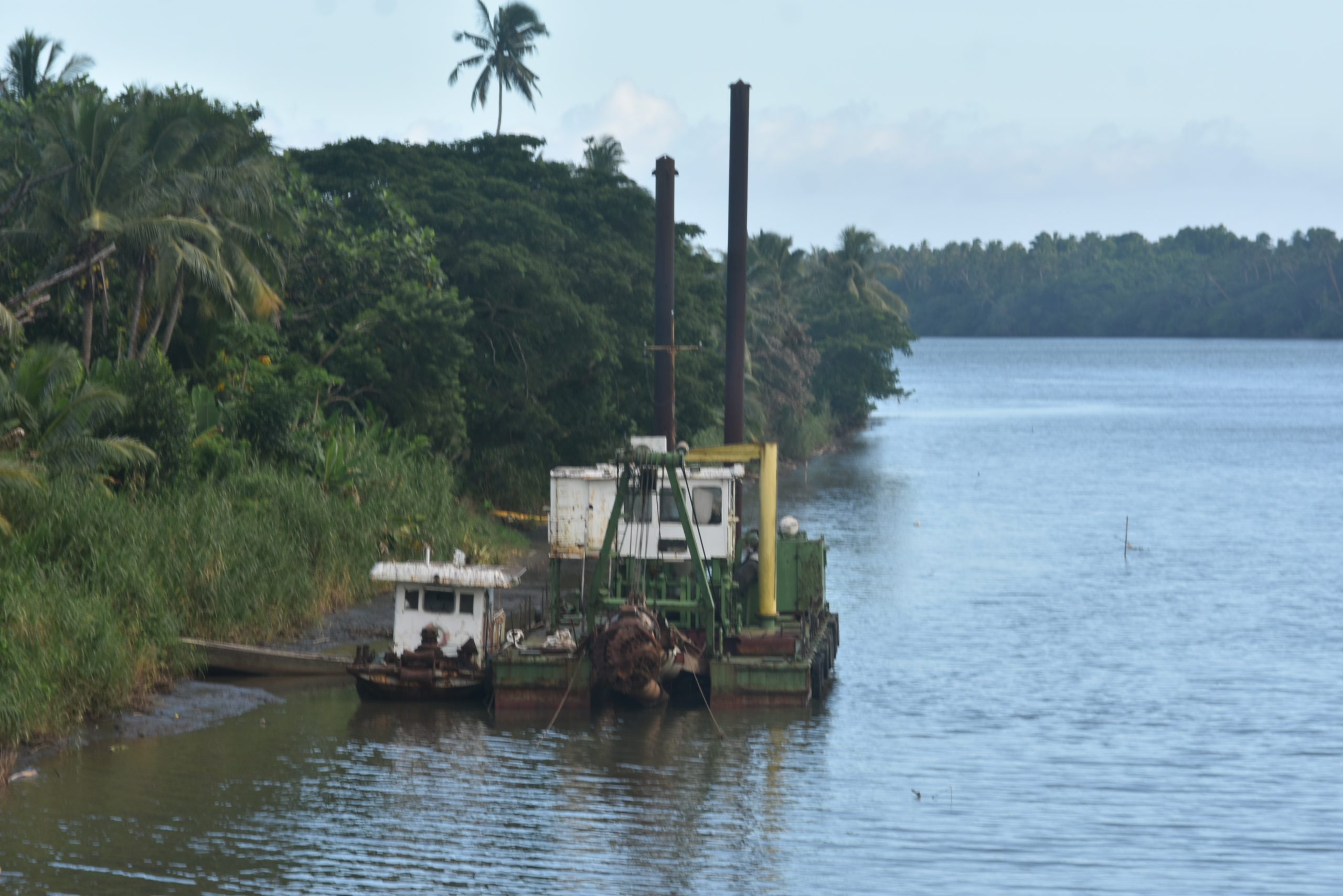As dredging works moved downstream in the Sigatoka River, Kulukukulu Village headman Christopher Herbert Work watched as the machines heading towards them dug up the river and spewed out sand and gravel to the riverbanks.
The gravel flung ashore destroyed coconut trees, gardens and mangrove vegetation, upon which they and their marine species had fed off for generations.
Mr Work said they had lost more than they would ever gain from the exercise.
His namesake and great-grandfather had sailed from the United States to Fiji in the 1800s to help establish the settlement on the main island, Viti Levu.
According to the family’s oral history, he picked up crabs along the way at Malolo Island and brought them to Kulukulu where he bred them for his family in mangroves near the river mouth.
Housewife Mira Work said the foresight and vision of that seafarer had helped generations of families at Kulukulu – a settlement of part-Europeans with links to nearby villages – to survive as development crept downstream.
”We lived off this once-pristine environment,” she said.
”I raised my children and grandchildren from what this environment produced. We had in abundance crabs, fish and vegetables that we farmed here.”
Mira is the mother of former Nadroga district footballers Jack, William and Charles, who is also a former national soccer captain.
”Today, most of the land is barren.”
”The gravel and sand extraction has buried land that once served as farms.”
Mrs Work said the dredging works came suddenly.
”The idea was ill conceived. There wasn’t much discussion about it.”
She said landowners who had agreed to it would live to regret the decision.
”This has been our life. Our children, our grandchildren once had bountiful.
”Now our future generations won’t enjoy the same blessings.
The most significant change brought on by the dredging is the disappearance of marine species in the river.
Kulukulu fisherman Isoa Chong-sue said they had been forced to venture out to sea, now that the bigger fish did not enter the river mouth.
”One day I caught a kawakawa (rock cod) and it came up with mud deep in its scales,” Chong-sue said.
”That shows that dredging exercise left some big holes in the riverbed. I calculated one to be 30 feet.
”The changed landscape down there has confused the marine life and deterred most species away.”
Gone too is the seasonal delicacy cigana (white bait), that arrives every Easter.
Schools of white bait in the millions would travel upstream, providing food for villages near the river mouth and up the Sigatoka Valley, as far as the cigana could travel.
Now the river is too shallow to accommodate them.
The herald for the Tui Nadruku, whose domain stretches for parts of land from the river mouth to the banks opposite Sigatoka Town, past his Laselase Village, said riverbank dwellers had been robbed of their feeding grounds.
”When the cigana used to arrive upstream, the whole river would turn a shade of red,” said Alipate Nainoca.
”Now we have accepted that the cigana is gone. So too the kakaka, the dole and saqa (travelly), which used to be in abundance here.”
Nainoca said bull sharks that used to swim upstream to give birth had also disappeared.
‘Fish from the hills and fish from the sea meet where saltwater meets freshwater. This is where they hatch their eggs.”
”We used to fish big kavu (a grouper species) lying next to the Sigatoka Bridge.
”We could spot them from the bridge. Now, they’re nowhere to be seen.”
Nainoca said that before the dredging project started, a team from a university visited the Tui Nadruku.
”They asked us ‘what’s so important about that river mouth?’
”I told them that all our history is there at the river mouth. Our identity, our history. Sites that tell us who we are.”
”That’s where Christianity arrived.”
The headman of Nayawa Village, Kaliova Vuki, a church youth leader, said he was one of eight Nayawa villagers who worked for the dredging company.
Vuki said sand filled the river faster than they could dredge it.
”For every 10 metres that we dredged, when we turned, it was filled again in no time,” he said.
”Our previous chief who had approved of dredging on our side of the river passed on, but not before witnessing the destruction their decision had allowed.”
”All our vegetation on the Muaisara Point side was buried by mountains of gravel.”
Environmental activist Lanieta Burasia, a former staff nurse at the Koromumu Hospital near her village of Vunavutu, said just as they had opposed the dredging, they would oppose any mining plan.
She said the people of tikina (district) o Nasigatoka (vanua o Jubaniwai) were against dredging at the river mouth and ancestral land.
Faith survives winds of change
The sun rises over the Sigatoka River, Alipate Nainoca, a former lawman and headman of Laselase Village, offers a prayer for wisdom and protection for the river and its people. The environmental changes brought on by dredging and the looming threat of mining have caused distress in the community, prompting Nainoca to seek solace and guidance in his faith.
Nainoca emphasises the responsibility of stewardship over the land, citing the Bible’s teachings on caring for the environment. He contrasts this with what he perceives as the growing greed displayed by some individuals in the face of globalisation.
The Sigatoka River mouth holds historical and spiritual significance for the people of Nadroga. It’s where Christianity first arrived in the region, and a cross stands as a reminder of the acceptance of faith by the Tui Madudu of Nayawa. The river mouth also serves as a final resting place for the Kulukulu community, a gift from the Tui Nadruku clan.
Nainoca, who is also a historian of Nadroga, said during the COVID pandemics of 2020 and 2022, people were turning to the word of God and planting for their food security.
He said people were taking divine advice in Genesis 3:19 in the Bible – “By the sweat of your brow you will eat your food, until you return to the ground since from it you were taken for dust you are and to dust you will return.”
Just as people learnt that lesson, it seemed they were changing just as fast in the face of globalisation and displaying greed in their decisions in the years that followed the national lockdowns.
Nainoca, drawing on oral histories, explained that the Tui Nadruku clan descended from Filipe Navakakala Tokololo, a commander under the paramount chief of Nadroga, the Na Ka Levu. Tokololo collaborated with Kulukulu settler Ezra (Moses) Walker Work, an American of Viking descent who arrived in the 1800s.
Local Methodist Church records narrate the Na Kalevu’s efforts to bring Christianity to the region. He sent an envoy to Viwa, a missionary hub, but found only one ailing missionary, Penijamini, remaining. Penijamini, a native of Sila, agreed to accompany the envoy. Sadly, he died en route and was buried in Navola, but his clothes, believed to possess spiritual power (mana), were carried on to fulfill his mission.
According to local lore, the mana-infused clothes emitted a radiant light, parting a vau tree forest on their journey. This event is commemorated in the saying “Koicalevu ina kalanivau”. The clothes were ultimately presented to the Na Kalevu, who embraced Christianity, leading to its widespread adoption in Nadroga/Navosa.
A cross near the river mouth at Muaisara marks the spot where the missionary’s cloak was received. This site, Nainoca emphasised, holds deep significance for both the cultural and spiritual identity of the region. Work, the Kulukulu settler, played a key role in spreading the gospel alongside Tokololo and the Na Kalevu. Their close relationship led to the Tui Nadruku granting the Kulukulu community a burial ground at Muaisara Point.
Ezra Walker Work married Adi Vani Wainiqiyawa around 1888.
They were the parents of at least five sons and a daughter. He died on November 23, 1897, in Sigatoka, at the age of 64, and was buried in Sigatoka.
Nainoca fears that Work “would turn in his grave” to see the community now grappling with environmental destruction and the potential for mining exploitation.
As the threat of mining looms for these riverside dwellers, some of Work’s descendants are cashing in on the crisis.
Fisherman Chong-sue said the problem brought on dredging had left mountains of sand and gravel on both sides of the river.
To get rid of them, individuals such as him were selling extracted sand and gravel to civil works companies.
That too has not gone down well with the villagers of Vunavutu, who lay claim to parts of the sand dunes.
”We oppose any extraction at the river mouth, by any individual, local or foreign,” Vunavutu activist Lanieta Burasia said.
”We say no to that. We say no to mining.”
As the currents and winds continue to change the landscape of the river mouth and the world-famous Sigatoka Sand Dunes, villagers said are praying for healing in the land and protection of the people from capitalism.
Sand swept in by the currents has buried part of the reef that once existed along that coast.
Nainoca – who is married to the Na Kalevu household, said the people of Nadroga must repent of their wrongdoings and return to the basics of good Christian living that his forefathers strove hard for.
”We must continue to pray and seek divine counsel for all we hope to do.”
”To love one another, be kind,and be good stewards of the environment.
”It feeds us, and we must be kind to it in return.”
- This article was first published as part of a three-part series by Pasifika News as part of the Earth Journalism Network (EJN) grant through the Pacific Islands News Association (PINA). This article does not necessarily reflect the views of this newspaper




